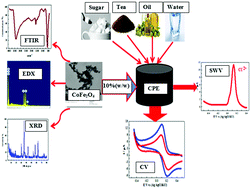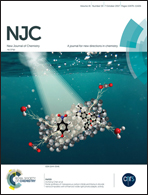Magnetic cobalt ferrite nanoparticles CoFe2O4 platform as an efficient sensor for trace determination of Cu(ii) in water samples and different food products†
Abstract
In the present work, we aimed to demonstrate the fabrication of a novel electrochemical sensor for the trace determination of Cu(II) in different food matrices. The new sensor was fabricated using cobalt ferrite nanoparticles (CoFe2O4) which were prepared via an eco-friendly green method. The prepared nanoparticles were investigated and characterized using different techniques. The described differential pulse anodic stripping voltammetry (DP-ASV) was optimized and validated. Under the optimal conditions, the sensor showed sensitive response to Cu determination over a wide linear range. The limits of detection and quantification were found to be 0.085 and 0.284 ppb, respectively, which are considered as lower than the reported limits. Furthermore, the developed method was applied for trace quantitation of Cu in water, oil, sugar and tea. This was carried out without interferences from various inorganic and organic species. Satisfactory recoveries of Cu from samples clearly revealed that the proposed sensor can be applied into quality control and routine determination of Cu samples.



 Please wait while we load your content...
Please wait while we load your content...